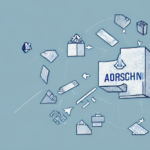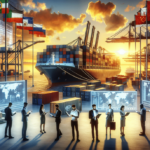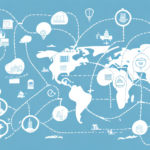Understanding the Rules of Origin in Supply Chain Management
Supply chain management is a complex process involving multiple parties and stakeholders. One of the most critical aspects of supply chain management is understanding the Rules of Origin (RoO) and how they impact international trade. This article provides a comprehensive overview of RoO, from the fundamentals to how technology can streamline compliance.
The Basics of Rules of Origin
Rules of Origin (RoO) are the criteria used to determine the originating country of a product. These rules are essential for verifying eligibility for preferential treatment under various trade agreements, such as reduced tariffs or exemptions. Companies must comply with RoO to take advantage of these trade benefits, which can significantly affect their cost structure and competitiveness.
RoO can vary widely depending on the specific trade agreement. For instance, some agreements may mandate that a specific percentage of a product's value is added in the originating country, while others require certain manufacturing processes to be completed domestically. Understanding the specific RoO for each trade agreement is crucial for ensuring compliance and securing preferential treatment.
Beyond facilitating trade benefits, RoO help prevent fraudulent practices and protect domestic industries. Without RoO, companies might import components from non-participating countries, assemble them in a participating country, and claim preferential treatment unfairly. This undermines the integrity of trade agreements and can harm domestic producers. By enforcing RoO, trade agreements ensure that benefits are granted only to products genuinely produced within the member countries.
Why Rules of Origin Matter in Supply Chain Management
RoO are fundamental to international trade and supply chain management as they ensure that preferential tariffs and trade benefits are appropriately applied. Accurate compliance with RoO promotes fair competition and encourages businesses to engage in cross-border trade more confidently. According to the World Trade Organization, accurate application of RoO can reduce trade disputes by up to 30%, streamlining customs procedures and minimizing delays.
Moreover, RoO play a significant role in maintaining product quality and safety within the supply chain. By verifying the origin of raw materials and components, RoO help prevent the use of substandard or hazardous materials in manufacturing. This not only safeguards consumers but also mitigates the risk of costly product recalls and reputational damage for businesses. Therefore, a thorough understanding and compliance with RoO are crucial for maintaining a competitive edge in the global market.
How Rules of Origin Affect Trade Agreements
RoO are integral to the negotiation and implementation of trade agreements. These rules determine which goods qualify for preferential treatment, such as lower tariffs, under specific agreements like the Free Trade Agreements (FTAs). Compliance with RoO is mandatory; failure to adhere can result in penalties and the loss of trade benefits.
Determining the country of origin can be complex, especially for products assembled from components sourced globally. This complexity can affect tariff classifications and compliance with trade regulations, potentially leading to increased costs and logistical challenges for businesses.
RoO can also influence the competitiveness of various industries. Strict RoO may disadvantage manufacturers in certain countries, limiting their ability to compete with firms from countries with more lenient rules. This can result in trade imbalances and affect the overall economic landscape.
The Different Types of Rules of Origin
There are several types of RoO used in international trade, each with its own criteria:
- Wholly Obtained Criterion - Products must be entirely produced within a single country.
- Change of Tariff Heading Criterion - Products must undergo a significant transformation that changes their tariff classification in the country of origin.
- Value-Added Criterion - A specified percentage of the product's total value must be added in the originating country.
Other RoO may stipulate specific manufacturing processes or minimum regional content percentages, depending on the trade agreement in question. For a detailed understanding of different RoO types, refer to the World Trade Organization's guidelines.
RoO are pivotal in determining tariffs, quotas, and other trade policies. They also prevent transshipment, the practice of routing goods through a third country to exploit lower tariffs or circumvent trade barriers. By enforcing RoO, trade agreements promote fair trade practices and protect domestic industries from unfair competition.
Determining a Product's Country of Origin
Establishing a product's country of origin can be challenging due to the global nature of supply chains. Accurate record-keeping of all sourcing and manufacturing locations is essential for traceability and compliance. Companies should implement consistent and transparent methods for determining origin to ensure adherence to RoO.
The substantial transformation test is a common method used to determine origin. This test assesses whether a product has undergone significant manufacturing changes in a particular country. If it has, that country is designated as the product's origin. For example, if a smartphone's components are assembled and significantly altered in Country A, then Country A is considered the origin.
Additionally, companies must comply with labeling requirements in the destination market. Some countries mandate the disclosure of a product's origin, which requires businesses to accurately reflect the origin based on RoO to avoid legal penalties. Ensuring compliance with these labeling standards is crucial for maintaining market access and consumer trust.
The Pros and Cons of Preferential Rules of Origin
Preferential RoO offer substantial benefits to companies involved in international trade, including duty-free or reduced-duty access to new markets. These advantages can facilitate business growth and enhance competitiveness. However, the complexity of preferential RoO can lead to increased administrative and compliance costs. Businesses must evaluate the costs and benefits of engaging in various trade agreements carefully.
One significant advantage of preferential RoO is the promotion of regional integration and cooperation. By encouraging companies to source inputs from within a specific region, preferential RoO help create more integrated and resilient supply chains. This integration can lead to increased trade, investment, and economic development within the region.
Conversely, preferential RoO can distort trade and investment patterns by incentivizing sourcing from within the region, even when it may not be the most efficient or cost-effective option. This can result in higher costs for businesses and consumers and reduce global competitiveness. Additionally, preferential RoO are susceptible to abuse and fraud, undermining the integrity of trade agreements and leading to unfair competition.
Common Challenges in Applying Rules of Origin
Applying RoO effectively presents several challenges for companies:
- Changes to the Supply Chain - Alterations in sourcing materials or components can impact a product's country of origin and RoO compliance.
- Record-Keeping - Maintaining accurate and comprehensive records of all sourcing and manufacturing activities is demanding and time-consuming.
- Interpretation of RoO - The complexity of RoO can lead to misinterpretation, resulting in compliance errors and potential disputes.
Another significant challenge is the lack of harmonization between different trade agreements. Diverse RoO across agreements can create confusion, increasing the risk of non-compliance. Additionally, determining the value of materials or components used in production is often difficult, particularly when sourced from multiple suppliers or undergoing substantial processing. Accurate valuation is crucial for compliance, as it directly affects the determination of origin.
Mitigating Risks in Rules of Origin Compliance
To mitigate risks associated with RoO compliance, companies can implement several strategies:
- Establish Clear Vendor Guidelines and Codes of Conduct - Ensure that all suppliers understand and adhere to RoO requirements.
- Implement Automated Record-Keeping and Compliance Management Tools - Utilize technology to maintain accurate records and streamline compliance processes.
- Engage with Trade Experts and Legal Counsel - Seek professional advice to navigate complex RoO and ensure compliance.
Conducting regular internal audits is another effective measure. Audits help identify potential compliance issues, allowing companies to address them proactively before violations occur. Additionally, investing in training and education programs for employees ensures that everyone involved in the supply chain understands the importance of RoO compliance and is equipped with the necessary knowledge and skills.
Best Practices for Managing Rules of Origin in Your Supply Chain
Effective management of RoO in the supply chain requires meticulous planning and execution. Here are some best practices:
- Develop a Standardized Process - Create consistent procedures for determining the country of origin for each product.
- Maintain Detailed Records - Keep comprehensive records of all sourcing and manufacturing locations to facilitate traceability.
- Implement an Ongoing Compliance Program - Continuously monitor and ensure adherence to RoO through regular reviews and updates.
Regularly reviewing and updating RoO policies and procedures is essential to stay aligned with changing regulations and trade agreements. Staying informed about updates from government agencies or industry associations and conducting periodic audits of the supply chain can help identify risks and areas for improvement. A proactive approach to managing RoO ensures compliance and minimizes the risk of penalties or supply chain disruptions.
How Technology Can Help Simplify Rules of Origin Compliance
Technological advancements have significantly simplified the management of RoO in supply chains. Automated record-keeping and compliance management tools reduce the likelihood of errors, ensure consistency, and minimize compliance risks. For example, ShipScience's supply chain software offers features that track supplier data and monitor compliance with RoO in real-time.
Additionally, technologies like blockchain enhance transparency and traceability, making it easier to verify the origin of products and components. Implementing such technologies can streamline compliance processes, reduce administrative burdens, and improve overall supply chain efficiency.
Future Trends in Rules of Origin and Supply Chain Management
As international trade continues to evolve, so too will the rules and regulations surrounding RoO. Future trends include the increased adoption of technologies like blockchain to enhance supply chain transparency and traceability. According to a report by McKinsey & Company, blockchain technology could reduce supply chain inefficiencies by up to 20% by 2025.
There is also a growing emphasis on sustainability and ethical sourcing, which will influence RoO. Trade agreements may increasingly incorporate environmental and social criteria, requiring companies to adhere to higher standards in their production processes. Adapting to these trends will be essential for companies aiming to maintain compliance and competitiveness in the global market.
Conclusion
Understanding and managing Rules of Origin (RoO) is crucial for ensuring compliance with international trade regulations and fostering fair competition. By adopting best practices and leveraging technology to streamline compliance processes, companies can minimize risks and capitalize on preferential treatment under various trade agreements. As the landscape of international trade continues to change, staying informed and adaptable is key to maintaining a competitive edge in the global marketplace.




















